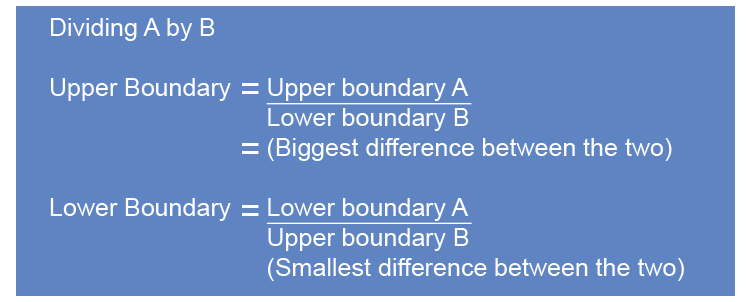Upper and lower boundary division
If you are looking to divide one quantity by another and you need to know the possible limits of the upper boundary and lower boundary use logic.

NOTE:
1. `Upper\ boundary=(Upper\ boundary\ A)/(Lower\ boundary\ B)`
If you have the largest possible amount and divide it by the smallest possible amount this will provide you with the biggest divisible number possible.
`Upper\ boundary=(Big)/(Small)=Lar\g\e\st\ n\u\mber`
2. `Lower\ boundary=(Lower\ boundary\ A)/(Upper\ boundary\ B)`
If you have the smallest possible amount and divide it by the largest possible amount this will provide you with the smallest divisible number possible.
`Lower\ boundary=(Small)/(Big)=Smal\l\e\st\ n\u\mber`
Example 1
`3.3m` and `4.2m` have been rounded to one decimal point.
What are the maximum and minimum values of `3.3div4.2m`?
First find the upper and lower boundary of `3.3m` which would be:
`3.3m` to one decimal place.
`3.ul3` underline the digit (`1^(st)` decimal place).
`3.ul30` look next door
`0` `5` or more raises the score. So `3.25` would raise to `3.3`.
`0` four or less just ignore `3.349dot9....` it would ignore and stay at `3.3`.
This is simplified to `3.35`
So the upper and lower boundary of `3.3m` to 1 D.P. is `3.35m` and `3.25m`.
The upper and lower boundary of`4.2m` which would be:
`4.2m` to one decimal place.
`4.ul2` underline the digit (`1^(st)` decimal place).
`4.ul20` look next door
`0` `5` or more raises the score. So `4.15` would raise to `4.2`.
`0` four or less just ignore `4.249dot9....` it would ignore and stay at `4.2`.
This is simplified to `4.25`
So the upper and lower boundary of `4.2m` to 1 D.P. is `4.25m` and `4.15m`.
Summary
Upper and lower boundary of `3.3m` is `3.35m` and `3.25m`
Upper and lower boundary of `4.2m` is `4.25m` and `4.15m`
To work out the upper boundary in division, we use the biggest difference between the two.
So the upper boundary of `(3.3)/(4.2)` is `(Big)/(Small)=(3.35)/(4.15)=0.81` to 2 D.P.
To work out the lower boundary in division, we use the smallest difference between the two.
So the lower boundary of `(3.3)/(4.2)` is `(Small)/(Big)=(3.25)/(4.25)=0.76` to 2 D.P.
Answer: The minimum and maximum values of `3.3div4.2m` is `0.81` and `0.76` to 2 D.P.
Example 2
The average fuel consumed by a car is given by the formula:
`fuel\ cons\u\m\ed=((d)\ dist\a\nce\ travel\l\e\d\ (kilometres))/((f)\ fuel\ used\ (litres))`
If `d=143` correct to 3 significant figures
`f=13.2` litres correct to 3 significant figures
Work out the lower boundary and upper boundary of fuel consumed.
First find the upper and lower boundary of `143` which would be:
`143` correct to 3 significant figures.
`14ul3` underline the digit (`3^(rd)` significant figure).
`14ul3.0` look next door
`0` `5` or more raises the score. So `142.5` would raise to `143`.
`0` four or less just ignore `143.49dot9.....` it would ignore and stay at `143`.
This is simplified to `143.5`
So the upper and lower boundary of `143` to 3 significant figures is `143.5` and `142.5`.
The upper and lower boundary of `13.2` to 3 significant figures would be:
`13.2` to 3 significant figures.
`13.ul2` underline the digit (`3^(rd)` significant figure).
`13.ul20` look next door
`0` `5` or more raises the score. So `13.15` would raise to `13.2`.
`0` four or less just ignore `13.249dot9......` it would ignore and stay at `13.2`.
This is simplified to `13.25`
So the upper and lower boundary of `13.2` to 3 significant figures is `13.25` and `13.15`.
Summary
Upper and lower boundary of `143` is `143.5m` and `142.5m`
Upper and lower boundary of `13.2` is `13.25m` and `13.15m`
i. To work out the upper boundary in division, you use the biggest difference between the two.
`(d)/(f)=(Big)/(Small)=(143.5)/(13.15)=10.91\ km//l` to 2 D.P.
ii. To work out the lower boundary in division, you use the smallest difference between the two.
`(d)/(f)=(Small)/(Big)=(142.5)/(13.25)=10.75\ km//l` to 2 D.P.
Answer:
The upper boundary of fuel consumed is `10.91\ km//l` to 2 D.P.
The lower boundary of fuel consumed is `0.75\ km//l` to 2 D.P.




